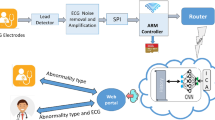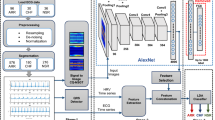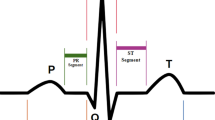Abstract
One among the major causes of death in the country is Heart disease (HD). 17.3 million deaths per year are caused by cardiac diseases, which is the primary reason for death in the globe as per the World Health Organization (WHO). Hence, the early detection of heart disease increases the survival rate. For an efficient detection of HD, a wide variety of techniques are used. But, the techniques rely on limited data; this degrades the accuracy and the performance of the model. So, to deal with these shortcomings, this paper has proposed Gaussian Kaiming Variance-based Deep Learning Neural Network (GKVDLNN) classifier for HD. In this study, the problem of heart disease detection using ECG and PCG signals is investigated, which provides valuable information about heart function. Thereby, the possible abnormalities of the heart are identified. Moreover, large data are used in this work to ensure the model’s accuracy. Firstly, from the publically accessible dataset, the input ECG along with PCG signals is gathered. Next, pre-processing is undergone by both signals. Utilizing Improved Empirical Mode Decomposition (IEMD), the signals are decomposed into bands after pre-processing. Then, for extracting the signal features, the decomposed bands are utilized. Then, for further process, the most suitable features are chosen as of the extracted features of both the ECG and PCG signals. After that, both the features are concatenated, and then classification is performed. In the classification process, the HD’s type is identified and classified by GKVDLNN. Experimental results stated the proposed model’s superiority and the proposed system withstands with 96.103% of accuracy with reduced costs. Overall, the method highlights the importance of early heart disease detection [32, 33] and provides a novel approach for achieving this goal through the integration of ECG and PCG signals with advanced signal processing and machine learning techniques [31].










Similar content being viewed by others
References
Khan RU, Hussain T, Quddus H, Haider A, Adnan, ZM (2019) An intelligent real-time heart diseases diagnosis algorithm, 2019 international conference on computing mathematics and engineering technologies, 30-31, Sukkur, Pakistan, 2019. https://doi.org/10.1109/ICOMET.2019.8673506
Abadi AM, Sumarna (2019) Construction of fuzzy system for classification of heart disease based on phonocardiogram signal, 2019 1st international conference on artificial intelligence and data Sciences,19-19, Ipoh, Malaysia, 2019. https://doi.org/10.1109/AiDAS47888.2019.8970975
Verma V, Dwivedi B, Singh S, Kumar G (2019) A novel approach to study electrical, mechanical and hydraulic activities of heart and their coordination based on ECG and PCG. Int J Appl Eng Res 14(2):227–231 https://www.ripublication.com/ijaerspl2019/ijaerv14n2spl_42.pdf
Yu L, Ye L, Zhuang W (2018) ECG signal classification with deep learning for heart disease identification, 2018 international conference on big data and artificial intelligence (BDAI), 22-24 June 2018, Beijing, China, https://doi.org/10.1109/BDAI.2018.8546681
Javeed A, Zhou S, Yongjian L, Qasim I, Noor A, Nour R, Basit SWA (2016) An intelligent learning system based on random search algorithm and optimized random forest model for improved heart disease detection. IEEE Access 4:1–11. https://doi.org/10.1109/ACCESS.2019.2952107
Low JX, Choo KW (2018) IoT-enabled heart monitoring device with signal de-noising and segmentation using discrete wavelet transform, 2018 15th International Conference on Control, Automation, Robotics and Vision, November 18–21, Singapore, https://doi.org/10.1109/ICARCV.2018.8581315
Low JX, Choo KW (2018) Automatic classification of periodic heart sounds using convolutional neural network, Int J Electric Comput Energ Electron Commun Eng. https://doi.org/10.5281/ZENODO.1315910
Vijayavanan M, Rathikarani V, Dhanalakshmi P (2014) Automatic classification of ECG signal for heart disease diagnosis using morphological features. Int J Comput Sci Eng Technol 5(4):449–455 http://www.ijcset.com/docs/IJCSET14-05-04-168.pdf
Somwanshi D, Tiwari R, Saini H, Gupta S (2018) ECG feature extraction and detection of first degree atrioventricular block, 3rd international conference and workshops on recent advances and innovations in Engineering, 22–25 November, https://doi.org/10.1109/ICRAIE.2018.8710343
Isina A, Ozdalili S (2017) Cardiac arrhythmia detection using deep learning. Proced Comput Sci 120:268–275. https://doi.org/10.1016/j.procs.2017.11.238
Zarrabi M, Parsaei H, Boostani R, Zare A, Dorfeshan Z, Zarrabi K, Kojuri J (2017) A system for accurately predicting the risk of myocardial infarction using pcg, ecg and clinical features. Biomed Eng Appl Basis Commun 29(3):1–10. https://doi.org/10.4015/S1016237217500235
Nedoma J, Fajkus M, Martinek R, Kepak S, Cubik J, Zabka S, Vasinek V (2017) Comparison of BCG, PCG and ECG signals in application of heart rate monitoring of the human body, 2017 40th International Conference on Telecommunications and Signal Processing , 5-7 July 2017, Barcelona, Spain https://doi.org/10.1109/TSP.2017.8076019
Latif S, Usman M, Rana R, Qadir J (2018) Phonocardiographicsensing using deep learning for abnormal heartbeat detection. IEEE Sens J 18(22):1–8. https://doi.org/10.48550/arXiv.1801.08322
Gjoreski M, Simjanoska M, Gradisek A, Peterlin A, Gams M, Poglajen G (2017) Chronic heart failure detection from heart sounds using a stack of machine-learning classifiers, 2017 13th international conference on intelligent environments, 21-25 Aug. 2017, Seoul, Korea (South), https://doi.org/10.1109/IE.2017.19
Gharehbaghi A, Linden M, Babic A (2019) An artificial intelligent-based model for detecting systolic pathological patterns of phonocardiogram based on time-growing neural network. Appl Soft Comput J 83:1–12. https://doi.org/10.1016/j.asoc.2019.105615
Amiri AM, Abtahi M, Constant N, Mankodiya K (2017) Mobile phonocardiogram diagnosis in newborns using support vector machine. Healthcare 5:1–10. https://doi.org/10.3390/healthcare5010016
Bao X, Deng Y, Gall N, Kamavuako EN (2020) Analysis of ECG and PCG time delay around auscultation sites, 13th international conference on bio-inspired systems and signal processing, January 2020, Valletta, Malta. https://www.scitepress.org/Papers/2020/89426/89426.pdf. Accessed 2021
Queyam AB, Pahuja SK, Singh D (2018) Doppler ultrasound based non-invasive heart rate telemonitoring system for wellbeing assessment. Int J Intell Syst Appl 12:69–79. https://doi.org/10.5815/ijisa.2018.12.07
Li H, Wang X, Liu C, Wang Y, Li P, Tang H, Yao L, Zhang H (2019) Dual-input neural network integrating feature extraction and deep learning for coronary artery disease detection using electrocardiogram and phonocardiogram. IEEE Access 7:146457–146469. https://doi.org/10.1109/ACCESS.2019.2943197
Khan MA (2020) An IoTframework for heart disease prediction based on MDCNN classifier. IEEE Access 8:34717–34727. https://doi.org/10.1109/ACCESS.2020.2974687
Yıldırım O, Pławiak P, Tan R-S, Acharya UR (2018) Arrhythmia detection using deep convolutional neural network with long duration ECG signals. Comput Biol Med 102:411–420. https://doi.org/10.1016/j.compbiomed.2018.09.009
Huang J, Chen B, Yao B, He W (2019) ECG arrhythmia classification using stft-based spectrogram and convolutional neural network. IEEE Access. https://doi.org/10.1109/ACCESS.2019.2928017
Ghosh SK, Ponnalagu RN, Tripathy RK, Rajendra Acharya U (2020) Automated detection of heart valve diseases using chirplet transform and multiclass composite classifier with PCG signals. Comput Biol Med 118:1–7. https://doi.org/10.1016/j.compbiomed.2020.103632
Alloqmani A, Abushark YB, Khan AI. Anomaly detection of breast cancer using deep learning. Arab J Sci Eng, pp 1–26. https://doi.org/10.1007/2Fs13369-023-07945-z
Alloqmani A, Abushark YB, Khan AI, Alsolami F (2021) Deep learning based anomaly detection in images: insights, challenges and recommendations. (IJACSA) Int J Adv Comput Sci Appl 12(4):205–21. https://thesai.org/Downloads/Volume12No4/Paper_28-Deep_Learning_based_Anomaly_Detection_in_Images.pdf
Khan AI, Abushark YB, Alsolami F, Almalawi A, Alam M, Kshirsagar P, Khan RA. Prediction of breast cancer based on computer vision and artificial intelligence techniques. Measurement, vol. 218, https://doi.org/10.1016/j.measurement.2023.113230
Manju BR, Sneha MR (2020) ECG Denoising Using Wiener Filter and Kalman Filter. Proced Comput Sci 171:273–281
Zhang D, Wang S, Li F, Tian S, Wang J, Ding X, Gong R (2020) An efficient ECG denoising method based on empirical mode decomposition, sample entropy and improved threshold function", Wireless Communication and Mobile Computing. pp 1–11, https://downloads.hindawi.com/journals/wcmc/2020/8811962.pdf. Accessed 2021
Niu XD, Lu LR, Wang J, Han XC, Li X, Wang LM (2021) An improved empirical mode decomposition based in local integral mean and its application in signal processing. Mathematical Problems in Engineering, pp 1–30, https://downloads.hindawi.com/journals/mpe/2021/8891217.pdf. Accessed 2021
Sharma V, Rasool A, Hajela G (2020) Prediction of heart disease using DNN, 2020 second international conference on inventive research in computing applications (ICIRCA), 15-17 July 2020, Coimbatore, India. https://doi.org/10.1109/ICIRCA48905.2020.9182991
Abdulsalam G, Meshoul S, Shaiba H (2023) Explainable heart disease prediction using ensemble-quantum machine learning approach. Intell Autom Soft Comput 36(1):761–779. https://doi.org/10.32604/iasc.2023.032262
Raza A, Tran KP, Koehl L, Li S (2022) Designing ECG monitoring healthcare system with federated transfer learning and explainable AI. Knowl-Based Syst 236:1–19. https://doi.org/10.1016/j.knosys.2021.107763
Taniguchi H, Takata T, Takechi M, Furukawa A, Iwasawa J, Kawamura A, Taniguchi T, Tamura Y (2021) Explainable artificial intelligence model for diagnosis of atrial fibrillation using holter electrocardiogram waveforms. Int Heart J 62(3):534–539. https://doi.org/10.1536/ihj.21-094
Kavila SD (2021) Explainable artificial intelligence to predict cardiovascular diseases. J Emerg Technol Innov Res 8(6):711–716. https://doi.org/10.6017/ITAL.V41I2.14683
Author information
Authors and Affiliations
Corresponding author
Ethics declarations
Competing interests
The authors have no relevant financial or non-financial interests to disclose.
The authors have no competing interests to declare that are relevant to the content of this article.
All authors certify that they have no affiliations with or involvement in any organization or entity with any financial interest or non-financial interest in the subject matter or materials discussed in this manuscript.
The authors have no financial or proprietary interests in any material discussed in this article.
Additional information
Publisher’s note
Springer Nature remains neutral with regard to jurisdictional claims in published maps and institutional affiliations.
Rights and permissions
Springer Nature or its licensor (e.g. a society or other partner) holds exclusive rights to this article under a publishing agreement with the author(s) or other rightsholder(s); author self-archiving of the accepted manuscript version of this article is solely governed by the terms of such publishing agreement and applicable law.
About this article
Cite this article
Jyothi, P., Pradeepini, G. Heart disease detection system based on ECG and PCG signals with the aid of GKVDLNN classifier. Multimed Tools Appl 83, 30587–30612 (2024). https://doi.org/10.1007/s11042-023-16562-9
Received:
Revised:
Accepted:
Published:
Issue Date:
DOI: https://doi.org/10.1007/s11042-023-16562-9




